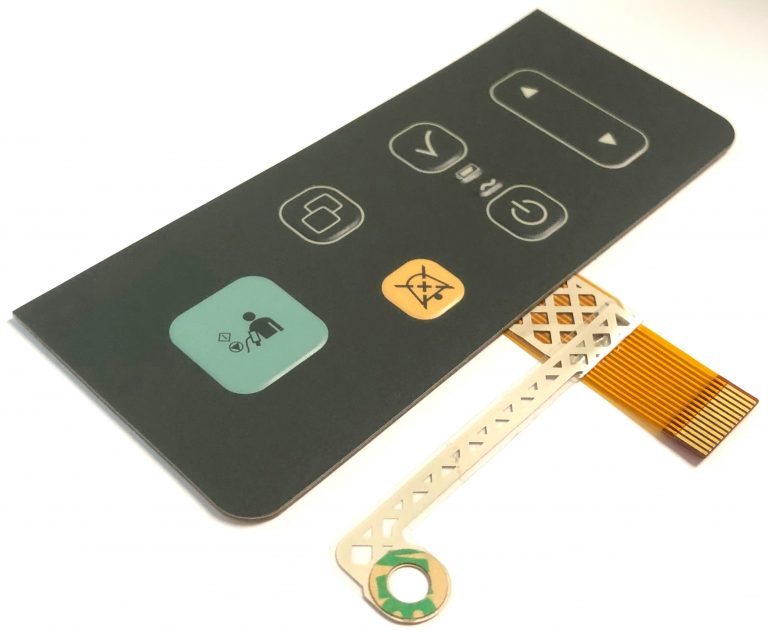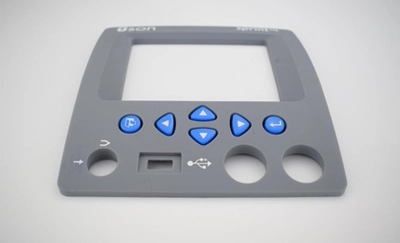Everything About Membrane Switch Over: A Comprehensive Guide for Beginners
Membrane layer switches are vital components in contemporary electronics, supplying a special interface for customer communication - membrane switch. Their split construction, consisting of overlays and conductive traces, provides functionality and durability. Unlike conventional mechanical switches, membrane layer switches provide a smooth style and adjustable options. Recognizing their essential features and benefits can change product style. The complexities of their application and layout factors to consider necessitate more expedition.
What Is a Membrane layer Change?
A membrane layer button is a type of electric button that contains an adaptable membrane layer layered over a printed motherboard. This style permits for a small and streamlined user interface, typically made use of in numerous digital devices. Membrane switches are generally found in consumer devices, medical tools, and industrial machinery due to their durability and resistance to environmental factors.The building usually consists of multiple layers, such as visuals overlays and adhesive support, which supply responsive responses and protect the circuitry below. The operation of a membrane switch is started when stress is used to the surface area, finishing an electric circuit.These switches are valued for their flexibility, enabling custom styles and published graphics that satisfy particular customer interfaces. Their inconspicuous nature reduces area needs, making them suitable for applications where traditional switches may not fit. In general, membrane layer buttons use a visual and useful solution for modern-day digital devices.
Secret Elements of Membrane Layer Changes
Membrane switches comprise several essential elements that add to their functionality and efficiency. The leading layer, referred to as the overlay, supplies the interface and is typically printed with graphics or signs. Beneath the overlay lies a spacer layer, which divides the conductive components and protects against unintentional activation. The following crucial element is the graphic layer, which enhances aesthetics and guarantees the sturdiness of the design.Conductive traces, commonly made from materials like silver or carbon, are printed on the circuit layer. When pressure is related to the overlay, these traces come right into get in touch with, completing the circuit. In addition, a support layer uses architectural support and can be made from products such as polyester or polycarbonate. With each other, these parts create a dependable, straightforward user interface appropriate for different applications, from house home appliances to commercial equipment. Understanding these components is necessary for anybody curious about membrane layer switch innovation.
Exactly How Membrane Switches Over Job
Recognizing just how membrane switches over feature is essential for valuing their extensive use in different tools. A membrane switch operates through a series of layers, including a visuals overlay, spacer, and a circuit layer. When pressure is put on the overlay, it compresses the spacer layer, allowing the circuit layer to make get in touch with and complete an electric circuit. This activity sends a signal to the tool, motivating a response, such as activating a light or triggering a function.Membrane switches over can be created with different functions, including tactile responses, backlighting, and customized graphics, improving user communication. Their construction permits for a covered design, shielding the inner components from dust, dampness, and impurities. This sturdiness makes them appropriate for diverse applications, from customer electronics to commercial tools. On the whole, the simplicity and effectiveness of membrane switches over add to their popularity in modern technology.
Benefits of Membrane Switches Mechanical Buttons
While mechanical buttons have actually long been a staple in lots of tools, membrane changes offer distinctive benefits that make them increasingly appealing. One considerable advantage is their slim account, allowing for more compact designs and greater adaptability in item growth. In addition, membrane changes feature an uniform surface area, which boosts visual charm and simplifies cleansing, making them ideal for atmospheres where hygiene is critical.Another advantage is their resistance to dust and dampness. Unlike mechanical buttons, which can be jeopardized by ecological aspects, membrane switches give a sealed user interface that shields versus pollutants - membrane switch. Additionally, membrane switches commonly have a longer life-span as a result of fewer moving components, leading to enhanced durability and reliability.Cost-effectiveness is additionally a remarkable advantage, as membrane buttons can be created wholesale with reduced manufacturing costs. These factors incorporate to place membrane switches as a sensible alternative to traditional mechanical choices in various applications
Typical Applications of Membrane Changes
Membrane layer switches are widely made use of in various industries, specifically in consumer electronics and commercial control board. more info here In consumer gadgets, they give a sleek, user-friendly user interface, while in commercial settings, they enhance longevity and functionality. Recognizing these applications highlights the flexibility and functionality of membrane layer buttons in modern technology.
Customer Electronics Gadgets
As customer electronics remain to evolve, membrane buttons have actually ended up being a preferred selection for a variety of gadgets as a result of their versatility and sleek design. These switches are typically discovered in mobile phones, tablet computers, and remotes, where room is minimal and looks issue. Their reduced account and customizable designs allow manufacturers to create user-friendly interfaces that enhance the overall individual experience. Furthermore, membrane switches are frequently utilized in appliances such as microwaves and coffee makers, providing user-friendly control alternatives while standing up to wetness and dust. The longevity and integrity of membrane layer switches over make them suitable for daily consumer products, making certain long life and check this regular performance. In general, their integration in customer electronic devices reflects a mix of capability and contemporary design.
Industrial Control Panels
The applications of membrane layer switches over prolong beyond customer electronics, finding substantial usage in industrial control board. These switches are favored for their longevity and resistance to rough atmospheres, making them perfect for making and process control settings. They supply a trustworthy interface for drivers to manage equipment, screen procedures, and change settings. Membrane layer switches can be personalized to suit certain operational demands, incorporating attributes like backlighting and tactile responses, improving customer experience. Their low-profile layout allows for assimilation into different tools, while their capability to withstand spills, dirt, and severe temperatures warranties longevity. On the whole, membrane switches add to efficient and risk-free operation in industrial applications, showing their adaptability and efficiency in requiring environments.
Factors To Consider for Creating Membrane Switches
When creating membrane layer switches, choosing the ideal products is necessary to assure sturdiness and capability. In addition, understanding layer setup strategies can substantially affect the switch's performance and individual experience. These factors to consider play a vital role in creating efficient and trusted membrane switch styles.
Material Choice Value
Product option plays a vital duty in the layout and capability of membrane layer buttons. The picked products straight my blog impact the switch's sturdiness, responsive action, and general visual. Trick factors to consider consist of the substratum, which have to supply architectural stability while enabling flexibility, and the graphic overlay, which requires to be immune to use and environmental factors. Conductive products must ensure reputable electrical performance, while adhesives have to use strong bonding without compromising the switch's procedure. In addition, compatibility with manufacturing processes and end-user environments is vital; materials need to withstand varying temperatures, moisture degrees, and chemical direct exposure. Ultimately, appropriate material selection not just boosts the membrane layer button's efficiency but likewise adds to its durability and user satisfaction, making it a vital aspect of the layout process.

Layer Arrangement Methods

Regularly Asked Questions
For How Long Do Membrane Layer Switches Over Usually Last?
Membrane switches usually have a lifespan of 1 to 5 million cycles, relying on usage and ecological problems. Elements such as layout quality and operating regularity significantly affect their resilience and general efficiency longevity.

Can Membrane Switches Over Be Custom-made for Details Layouts?
Membrane layer switches can certainly be customized to accommodate specific layouts, permitting diverse shapes, shades, and capabilities. This adaptability allows producers to tailor these buttons to satisfy unique visual and functional requirements properly.
What Products Are Used in Membrane Switch Over Building And Construction?
Membrane buttons are usually constructed making use of materials such as polyester, polycarbonate, and glue layers. These materials give adaptability, resistance, and resilience to environmental aspects, ensuring the switches work successfully in different applications and problems.
Are Membrane Switches Immune or waterproof to Wetness?
Membrane layer buttons can be made to be moisture-resistant, utilizing specialized products and coatings. However, their water resistant abilities rely on construction quality and particular applications, making it vital to analyze needs for perfect performance in various atmospheres.
Just How Are Membrane Layer Switches Over Fixed if Damaged?
Repairing damaged membrane switches over commonly entails changing the impacted layer or circuit. Service technicians might likewise apply conductive adhesive or make use of specialized fixing packages, making sure performance is brought back without complete substitute of the whole switch assembly. Unlike traditional mechanical buttons, membrane layer switches present a streamlined layout and adjustable choices. A membrane button is a type of electrical button that is composed of a flexible membrane layer layered over a printed circuit board. The operation of a membrane button is started when pressure is applied to the surface, finishing an electrical circuit.These switches are valued for their versatility, enabling personalized styles and published graphics that provide to specific individual interfaces. While mechanical switches have actually long been a staple in numerous tools, membrane switches offer distinct benefits that make them increasingly appealing. Membrane layer switches commonly have a longer life expectancy due to less moving components, resulting in enhanced longevity and reliability.Cost-effectiveness is likewise a notable benefit, as membrane layer switches can be generated in bulk with lower production expenses.